The NZ Book Awards for Children and Young Adults are a unique celebration of the contribution New Zealand’s children’s authors and illustrators make to building national identity and cultural heritage.
Awards in the New Zealand Book Awards for Children and Young Adults are made in six categories. All awards carry prize money of $7,500. In addition, the judges may decide to award a best first book prize of $2,000 to a previously unpublished author or illustrator. The overall prize, the Margaret Mahy Book of the Year award, carries a prize of $7,500. The awards are judged by a panel of five, and Te Kura Pounamu is judged by a separate panel of judges. This year’s winners will be announced at an event in Wellington on 8 August.
This year we present each title with a short piece of review commentary from Sarah Forster, one of 2017’s judges. She’s even included her cheeky picks for winners at the bottom of each section – it’s much easier to throw these out when there is just one of you! You’ll also find links to coverage of these titles, and in the coming weeks The Sapling will be celebrating the finalists for each of these categories.
Congratulations to the finalists for 2018 …
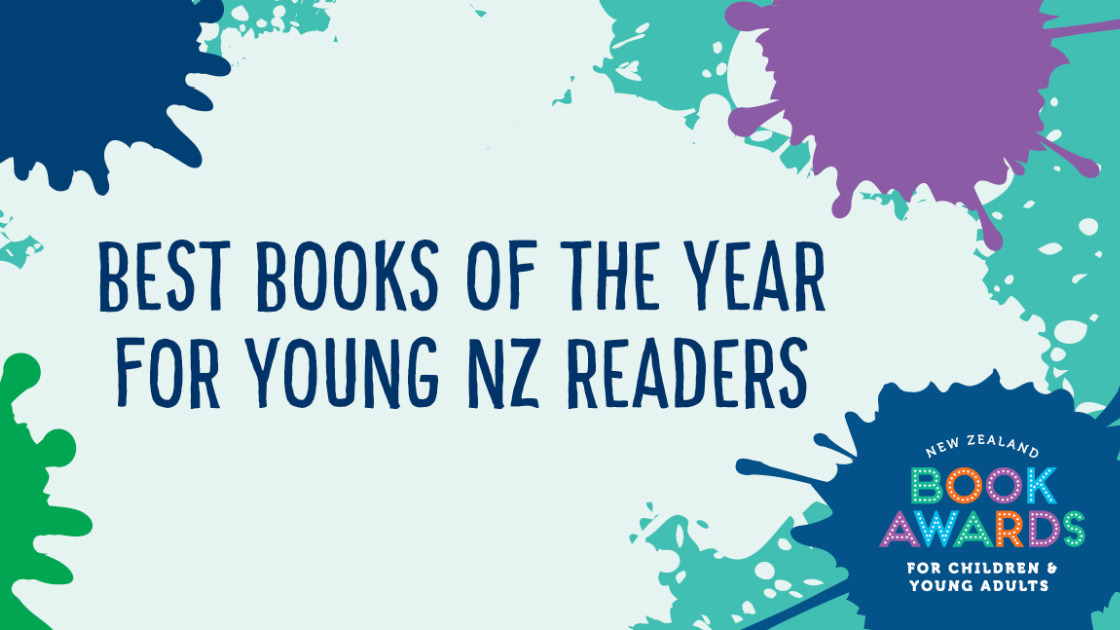
The Picture Book Award Finalists
The best picture books are a type of poetry, so it is always delightful to see the best poets turn to writing picture books. This is always the most populated category, so the most difficult to choose, and these books are certainly great representatives of the books from 2017/18.
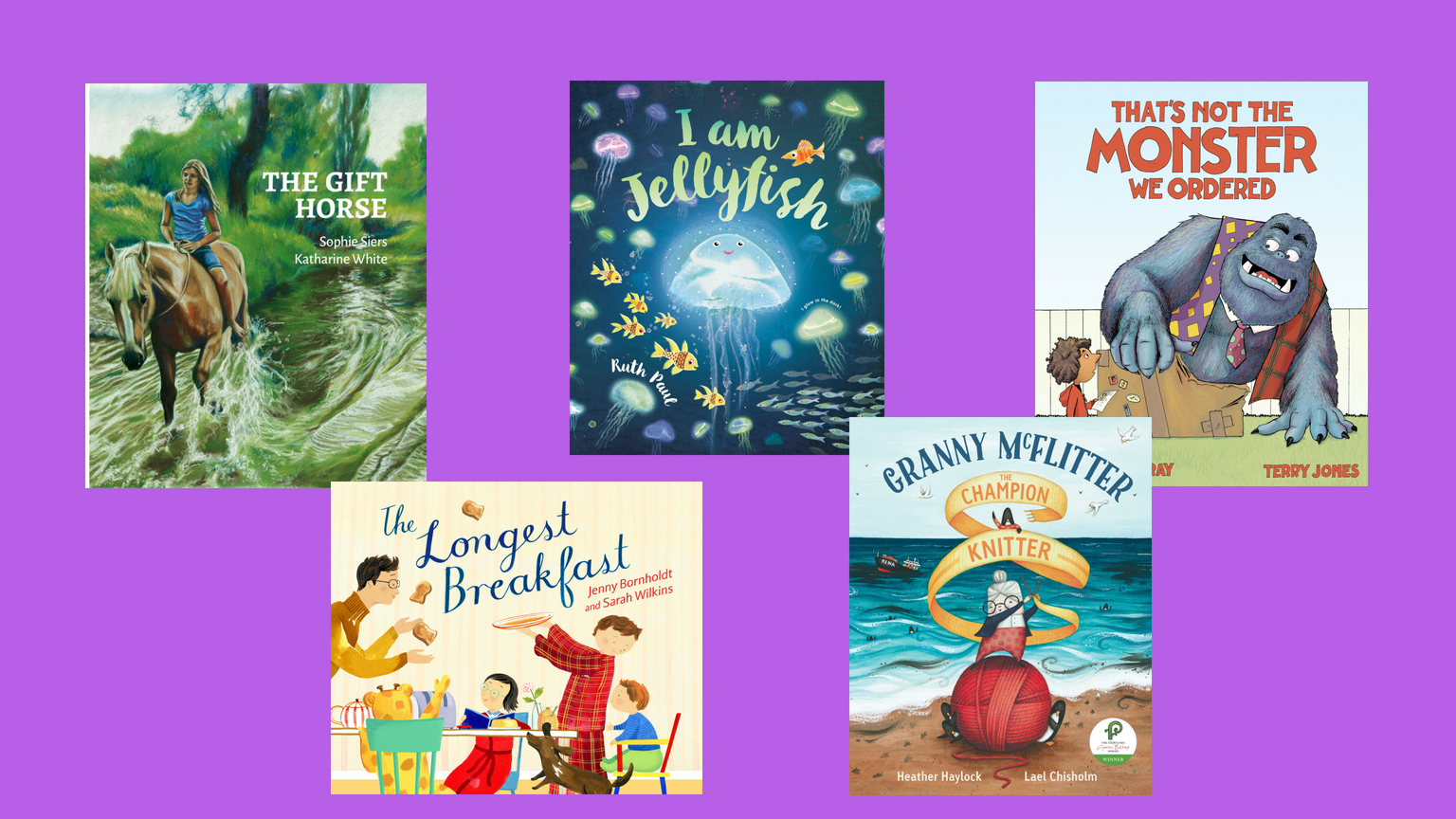
Granny McFlitter the Champion Knitter, by Heather Haylock and Lael Chisholm (Puffin NZ)
You possibly wouldn’t predict that this book was about protecting the environment from the title, but it is! Great rhyme and awesome – already award-winning – illustrations from a first time writer / illustrator combination.
I am Jellyfish, by Ruth Paul (Puffin NZ )
This glorious celebration of the jellyfish’s sometimes-forgotten role in the world of the ocean serves as a reminder that it takes all fish to create a harmonious ocean. The colour palette glows in the depths of the ocean, while the rhyme is gentle and clever.
That’s Not the Monster We Ordered, by Richard Fairgray, Tara Black and Terry Jones (Puffin NZ)
This tale about learning that there is a place in your family for every monster, is delivered sweetly and with wacky humour. The brilliant comic-style illustration is characteristic of Fairgray, Black and Jones’ work.
The Gift Horse, by Sophie Siers and Katharine White (Millwood Press)
Sometimes picture books aren’t for little kids, and this beautifully illustrated book of grief is one of them. Olivia’s story of grief is told with the perfect weighting of text and illustration.
The Longest Breakfast, by Jenny Bornholdt and Sarah Wilkins (Gecko Press)
The morning chaos in a single-parent household is brought to life in a busy story, with a large diverse cast of characters (mainly kids), and a baby who knows exactly what he wants. The illustrations are often unexpected, and always perfectly matched to the writing.
I love picture books that bring joy and have deeper meaning, so my pick for this year from these finalists is I am Jellyfish, by Ruth Paul. It’s a tough one though, and I’ll willingly say my pick will probably diverge from the judges pick!
The Wright Family Foundation Esther Glen Award for Junior Fiction award Finalists
First-person narration is where it is at this year for the finalist selection for the Esther Glen Award. I loved each of these books, yet there were others I had expected to see in this group.
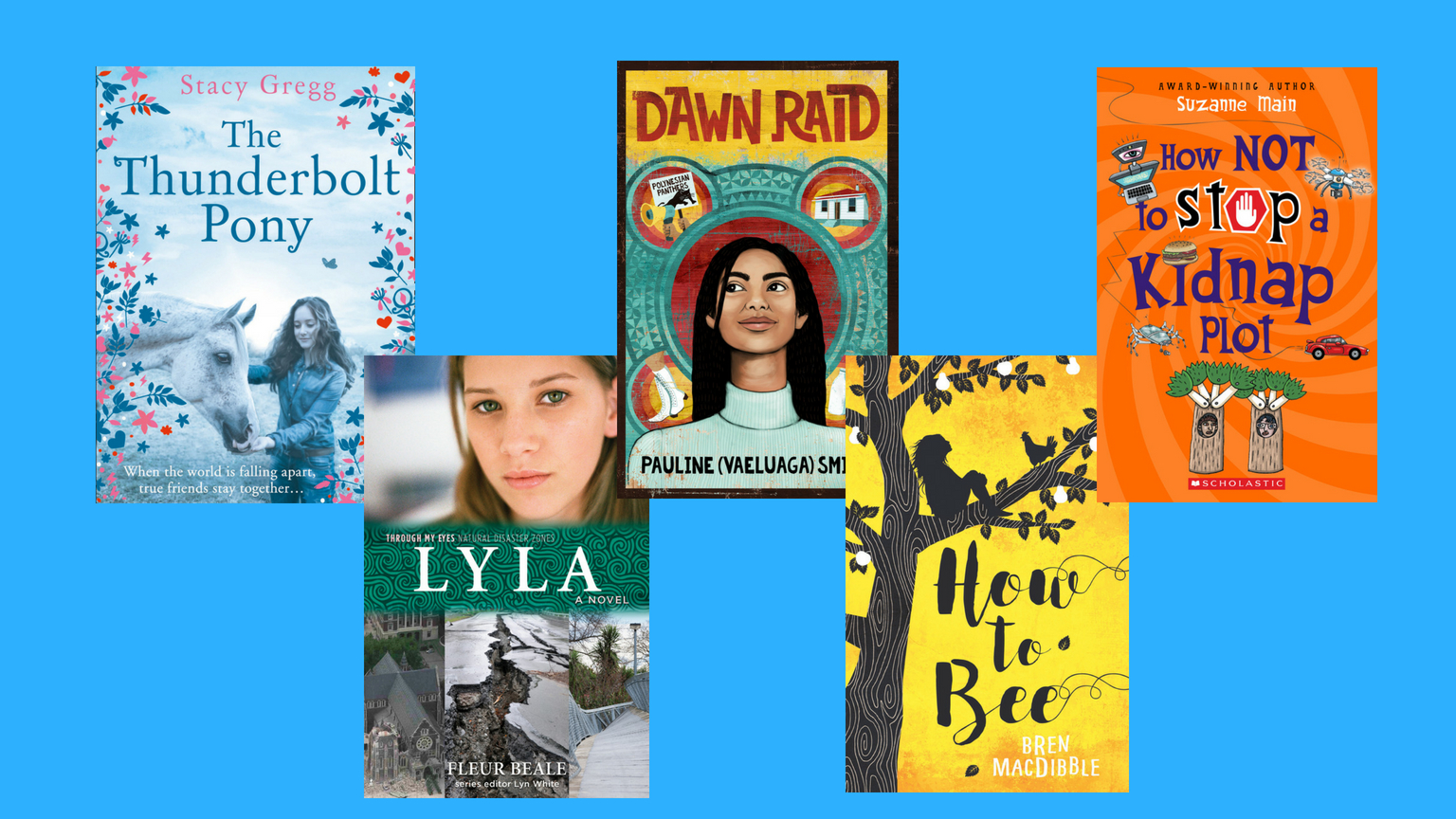
Lyla: Through my Eyes, by Fleur Beale (Allen & Unwin)
Fleur Beale’s character Lyla is gutsy and determined, and keeps her neighbourhood together while her parents and the teenagers help in other spaces around the city after the Christchurch earthquakes. Beale makes Lyla brave, but not super-human, and keeps our attention in the right places in this great book.
The Thunderbolt Pony, by Stacy Gregg (HarperCollins)
I was blown away by this story from Stacy Gregg, which blends her ability at writing horse-based tales, with her skill with character and pacing, to bring a very personal story to life. This book had me on the edge of my seat, as Evie takes her horse, dog and cat, plus her OCD, along the broken road to Kaikoura after the 7.8 earthquake.
How to Bee, by Bren MacDibble (Allen & Unwin)
This was one of my favourite junior fiction books last year. All Peony wants is to be a bee – a human pollinator, taking over the natural role of bees. The unique tone of Peony’s first-person narration makes this an immersive, and terrifying read, about our possible future.
Dawn Raid, by Pauline Vaeluaga Smith (Scholastic NZ)
Smith has nailed the internal drama of a 13-year-old girl, while ensuring she gets the point of the story without relying on big blocks of explanation. This is a horrific true story of the open racism of the Muldoon Government, but the humour Smith brings into Sofia’s voice ensures it is still suitable for its target age group.
How NOT to stop a Kidnap Plot, by Suzanne Main (Scholastic NZ)
Michael and Elvis are back, and this time they accidentally find themselves in the know about a kidnap plot against rich boy Angus. A funny and compelling tale that keeps you guessing until the end, with great one-liners and a frenetic pace.
Now this is possibly because I have had longer to sit with it, but to me How to Bee does everything I want in a junior fiction book, and everything a child likes in a story. While each of the others are truly great books, this has the feel of a classic.
The Elsie Locke Award for Non-Fiction Finalists
This is the oldest-pitched non-fiction list we have had in years for these Book Awards. It is wonderful to see publishers and authors re-invigorating this discipline with well-considered books on subjects that have deserved closer attention for some time.
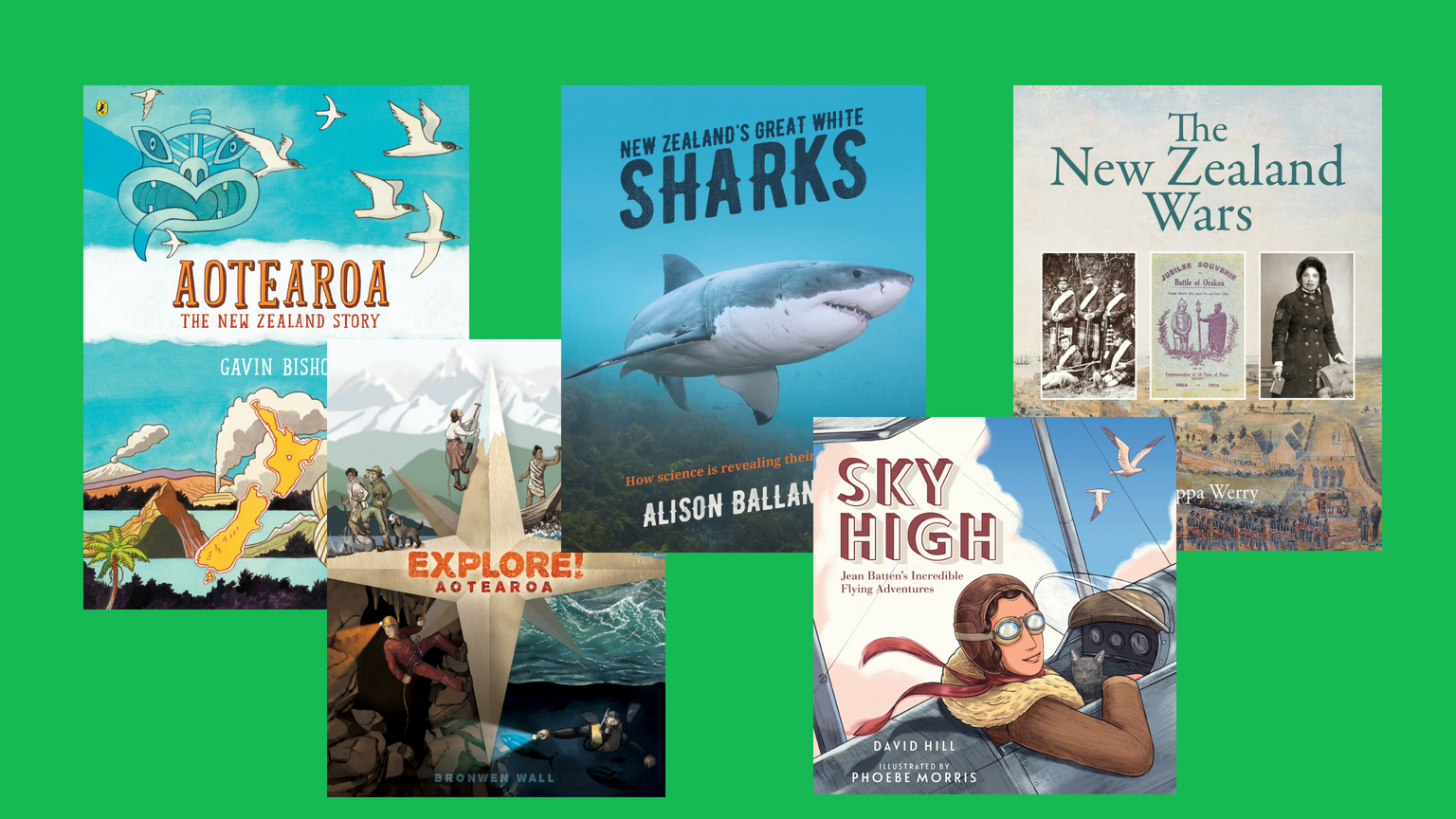
Explore! Aotearoa, by Bronwen Wall (Kennett Brothers)
A book telling stories of some of our most courageous and adventurous explorers in enough detail to let you sink into the stories. It appears though, that there aren’t nearly enough women in New Zealand’s history of exploration. Surely they were there?! Come on, girls, let’s go.
The New Zealand Wars, by Philippa Werry (New Holland Publishers)
There’s nothing quite like colonial history to make you want to cover your head in shame. This is an excellent, clearly told history of the New Zealand Wars, with relevant images and great story-telling. Werry has done an excellent job of explaining a challenging topic that will now hopefully become more widely studied in schools.
Aotearoa, by Gavin Bishop (Puffin NZ)
Still on the bestsellers list eight months after its release, Aotearoa is arguably the one to beat this year at the Book Awards. Over 64 beautiful pages, Bishop explores the history of our land, beginning with a time-based structure, then moving into story pages. A must-have for every family in New Zealand.
New Zealand’s Great White Sharks, by Alison Ballance (Potton & Burton)
Meaty enough to satisfy adults, but accessible for keen youngsters. My six-year-old was entranced. The sharks and scientists are the stars of the show, and their travels and discoveries are divided into easy chapters, and illustrated with scores of photographs, maps and diagrams. Recommended for scientists of all ages. (TKR)
Sky High: Jean Batten’s Incredible Flying Machine, by David Hill and Phoebe Morris (Puffin NZ)
This pairing has settled into an easy companionship with their writing and illustration, with Hill bringing his storytelling skill to the picture book medium once again, to tell the story of the wonderful Jean Batten. Morris’s illustrations again bring a fresh edge to the historically rooted tale.
It’s a tougher call than I would have expected, but for me Aotearoa has to take this one out, for the fact that it has already become a classic. Though I can see that arguably others deliver their information in a clearer manner, so I wonder!
The Copyright Licensing NZ Award for Young Adult Fiction Finalists
It’s a great mix of reality and world-building in this category this year, showing New Zealand writers can deliver, no matter your reading taste. From pig-hunting as a means of self-discovery, to a journey through depression; from steampunk spies, to sympathetic bee-like aliens, and a teen cancer love story – this list has got it all.
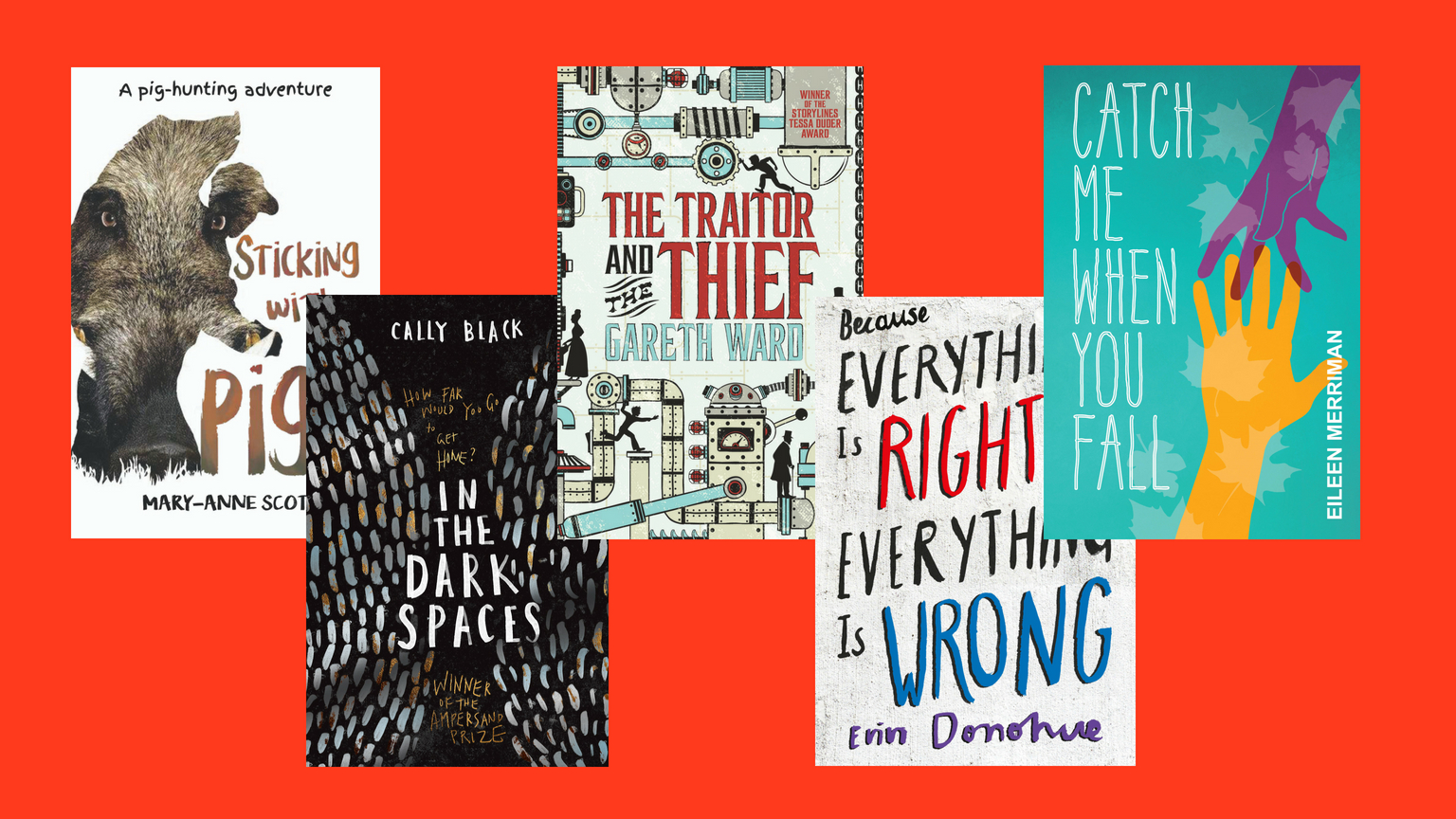
Sticking with Pigs, by Mary-Anne Scott (OneTree House)
This tautly told book is spot-on, with all the complications of being a teenage male elucidated beautifully by Scott. The pace of the story is irrepressible, even as you feel a little ill at the rather ripe descriptions of what exactly carrying a dead pig piggyback feels like.
Because Everything is Right but Everything is Wrong, by Erin Donohue (Escalator Press)
This book is terrifyingly personal, pulling me into the depths of a mentally ill teenager’s mind more effectively than any book I’d read before or since. This is real, and vital writing.
The Traitor and the Thief, by Gareth Ward (Walker Books Aus)
The steampunk setting is so realistic that you can hear the machinery squeak, as Sin finds himself taken into a covert group of underground spies. Ward does a brilliant job of stringing us along with a strongly-held plot, and some ingenious character names. Easily the best cover design of the lot!
In the Dark Spaces, by Cally Black (Hardie Grant Egmont)
Tamara is the near-sole survivor of an alien attack in the space freighter in which she is a stowaway, only to be taken to an alien hive – away from her baby brother Tamiki. It’s an excellent read, with the world of the aliens and the future humans built clearly, and the bold voice of Tamara carrying us through her situation.
Catch me When you Fall, by Eileen Merriman (Puffin NZ)
What happens when the cancer you thought you’d beaten comes back, just as you meet a boy whom you think is the love of your life? Teenage Alex goes through a lot in these pages, but never loses sight of herself. Merriman is an author who is hitting her stride, and her experience as a haemotologist is well-utilised in this gripping read.
Ohh this is a tough one. To me, the book in this group that speaks most closely to a teen experience while telling a compelling story is Catch me When you Fall, by Eileen Merriman.
The Russell Clark Award for Illustration Finalists
With the rolling seas, the calm deep ocean, the sky above and tunnels beneath – plus a well-told graphic novel – these awards are celebrating a great range of New Zealand illustration. The comic is impressive in its breadth, while both Ruth Paul and Jenny Cooper’s titles are particular favourites for me. Well done, judges!
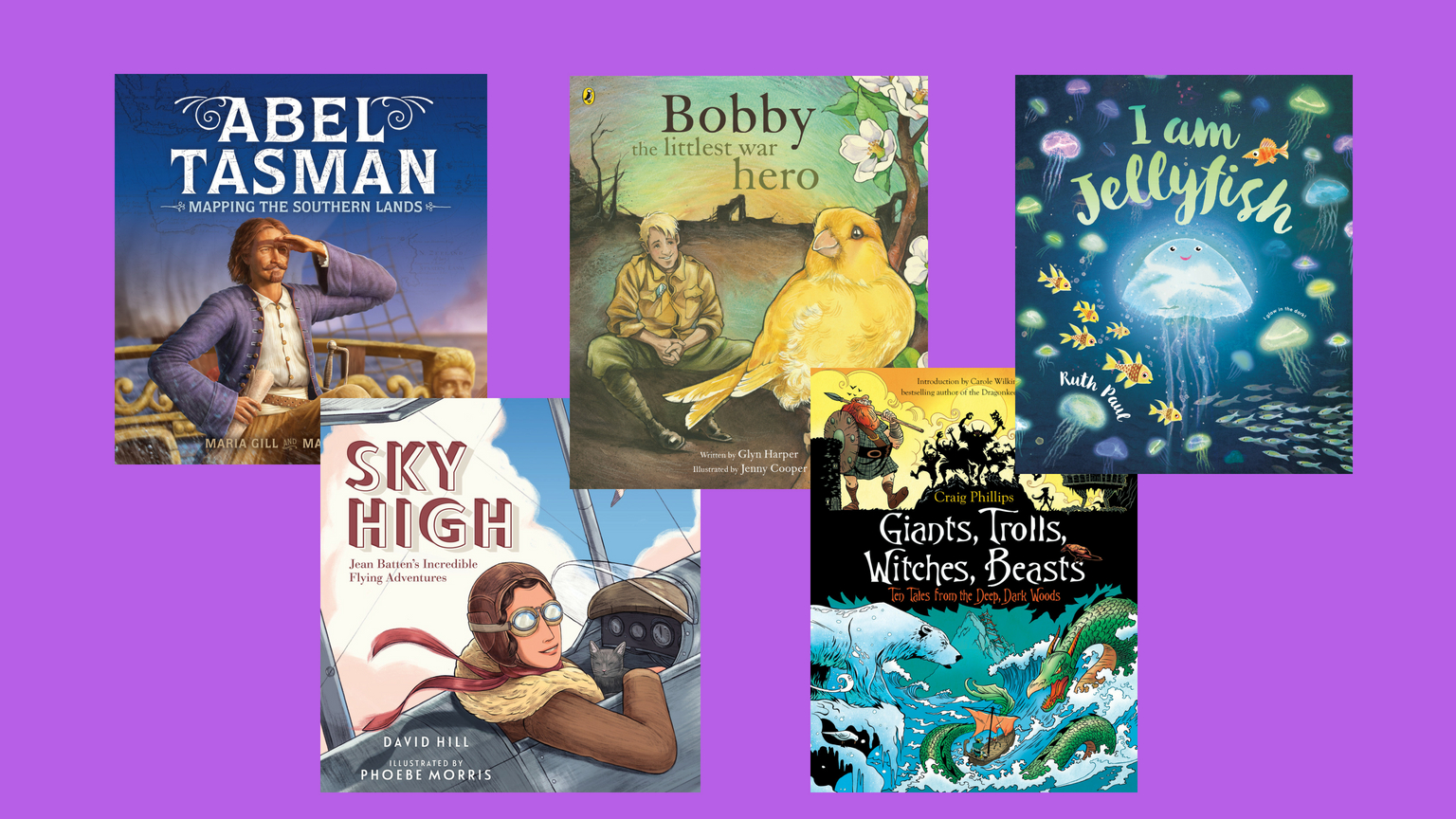
Abel Tasman: Mapping the Southern Lands, illustrated by Marco Ivancic (Scholastic NZ)
I frequently have to blink twice when looking at Marco’s illustrations, to reassure myself that they are in fact illustrated, rather than photographed. His skill for photo realism is incredible, and his waves in one scene of this book practically leapt out and splashed me.
Bobby, the Littlest War Hero, illustrated by Jenny Cooper (Puffin NZ) Jenny Cooper definitely does her share of storytelling in this book. The use of yellow tones in this book struck me – gaslight echoing the canary, and the yellows in the uniforms. Cooper also showed her skill with some great perspectives of tunnelling during the war.
Giants, Trolls, Witches, Beasts: Ten Tales from the Deep Dark Wood, illustrated by Craig Phillips (Allen & Unwin)
The design, style and execution of this book is a thing of wonder. Craig Phillips’ lines are crisp and intuitive, and his colours rich and inviting. A real find, from an illustrator who is new to me.
I am Jellyfish, by Ruth Paul (Puffin NZ)
Ruth Paul’s colour palette glows against the deep ocean background in this gorgeous, perfectly toned book. There is a lot of space in the sea, but Paul had everything in exactly the right place.
Sky High: Jean Batten’s Incredible Flying Adventures, illustrated by Phoebe Morris (Puffin NZ)
Phoebe Morris had everything in its place in the air, with great variation in views as she helped to tell the story of Jean Batten. Her small characters were some of my favourites, with plenty of expression and attitude shown by Batten through the illustrations.
Look, I have no idea how the judges have judged a graphic novel against picture books – but my favourite of the picture books is Sky High: Jean Batten’s Incredible Flying Adventures, illustrated by Phoebe Morris. But I also love Craig Phillips’ work! Buy them both!
The Best First Book Award Finalists
Three of these books are in other categories, showing the level of our new talent is on the rise, especially in the YA and junior fiction markets. It’s great to see that each of these books is from a different publisher, as it shows that new blood is being encouraged in many spaces.
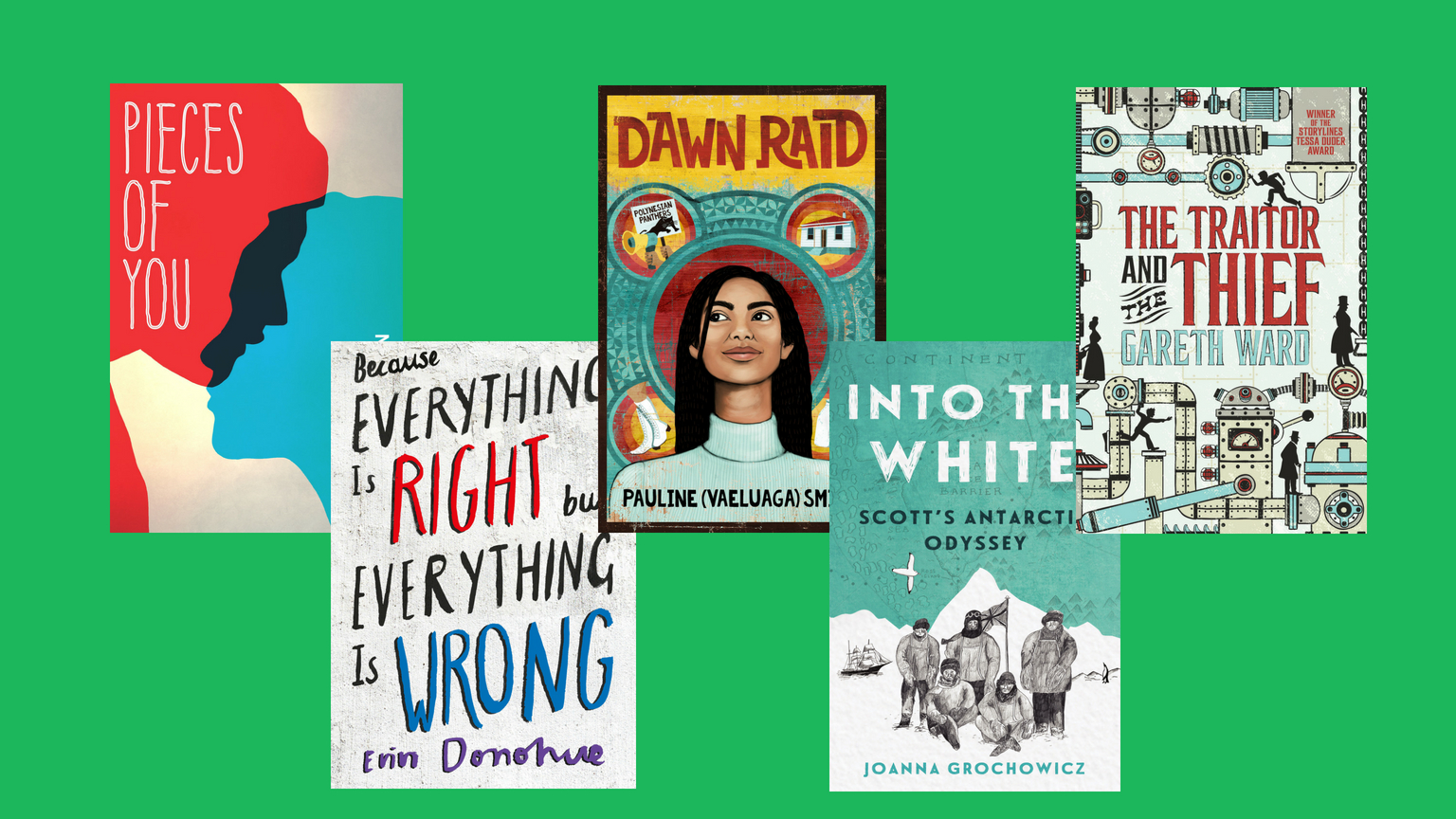
Because Everything is Right, but Everything is Wrong, by Erin Donohue (Escalator Press)
Like looking into the head of a teenager. So close it hurts.
Into the White, by Joanna Grochowicz (Allen & Unwin)
I found it surprising that this wasn’t in the shortlist for the main junior fiction (or non-fiction) prize, as this book blew me away last year. The adventure and competition, and the complexity of arrangements required to get to the South Pole in 1908, are all described as though you are there. Just mind-blowing.
My New Zealand Story: Dawn Raid, by Pauline (Vaeluaga) Smith (Scholastic NZ)
So freaking good, this story includes the details of a teenager’s life whilst telling us a true story.
Pieces of You, by Eileen Merriman (Penguin NZ)
Merriman’s first YA novel, which opens with a scene where the main character cuts herself, and stays in a heightened sense of drama throughout. My favourite part of this book was that each chapter title was named after a classic book.
The Traitor and the Thief, by Gareth Ward (Walker Books)
Sin is a brilliant character and this is a great first book in a proposed series. Go on, Walker, sign the next one!
My pick of this lot is Because Everything is Right, but Everything is Wrong. Erin Donohue is bound to go far.
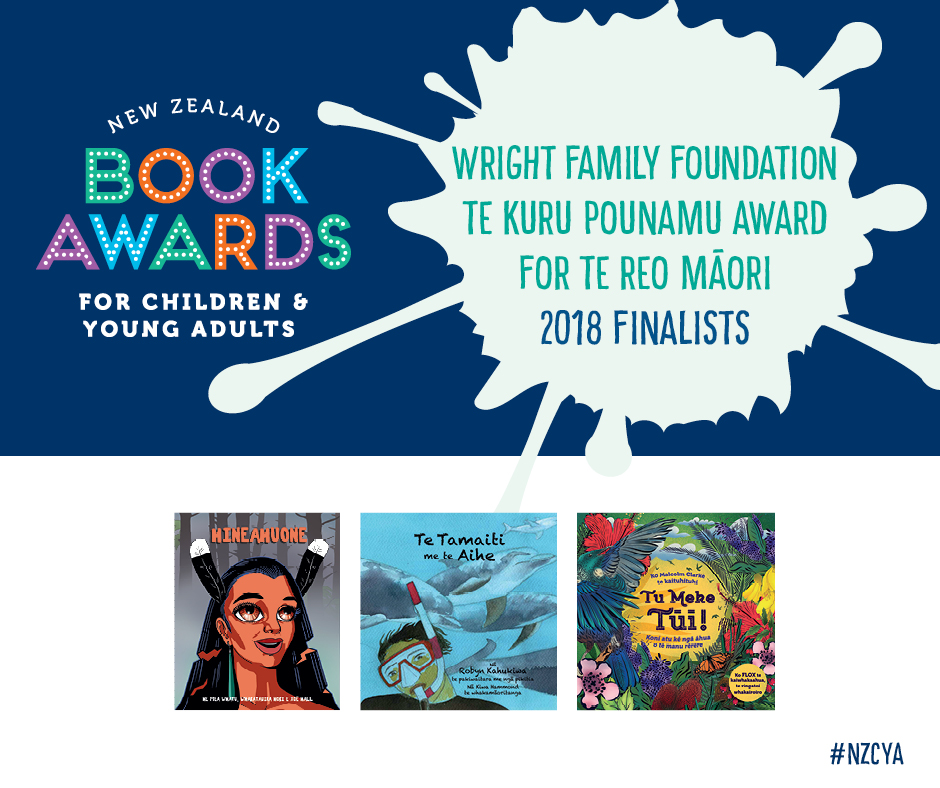
Wright Family Foundation Te Kura Pounamu Award for books written completely in te reo Māori
The Sapling will be running reviews of each of these finalists, which are decided by a different judging group to the rest of the awards. As our editors are not fluent, you will need to wait until these for thoughts and opinions! Here are your finalists:
Hineahuone, by Xoë Hall, translated by Sian Montgomery-Neutze (TeacherTalk)
Te Tamaiti me te Aihe, by Robyn Kahukiwa, translated by Kiwa Hammond (Little Island Press Ltd)
Tu Meke Tūī! by Malcolm Clarke, illustrated by Hayley King (AKA Flox), translated by Evelyn Tobin (Mary Egan Publishing)



